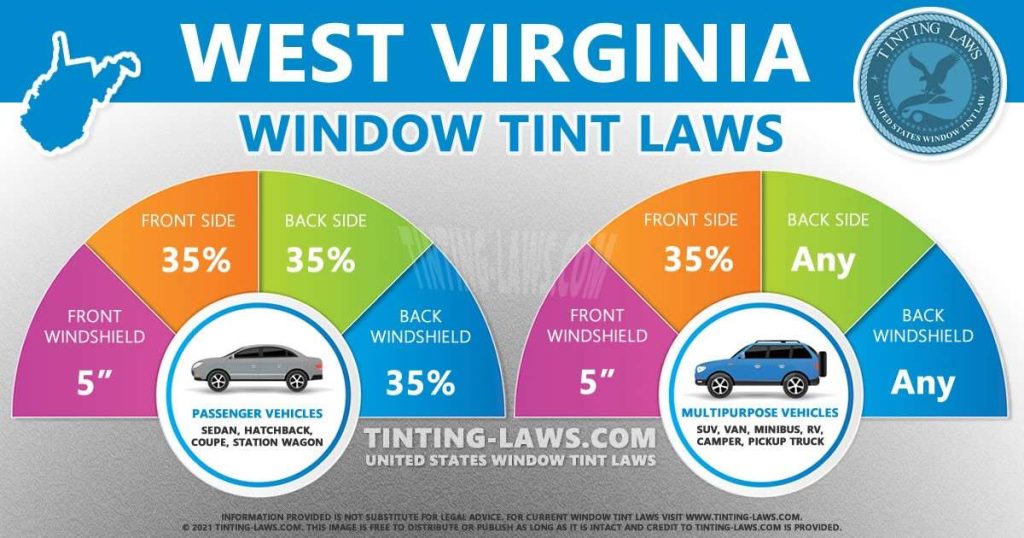West Virginia Window Tinting Laws
Car window tinting laws in West Virginia were enacted in 1991.
We have provided all the necessary information about your car’s window tint, including how dark or reflective the tint is allowed in your state.
There are also additional car window tinting rules and regulations in West Virginia so make sure you read all about it below.
Window tint darkness in West Virginia
The percent of visible light allowed through your car windows is called VLT: Visible Light Transmission.
The percentage of light allowed through your film and glass in West Virginia is very specific and different for sedan cars and SUV cars or vans.
Tint darkness for sedans:
- Windshield: Non-reflective tint is allowed on the top 5 inches of the windshield.
- Front Side windows: Must allow more than 35% of light in.
- Back Side windows: Must allow more than 35% of light in.
- Rear Window: Must allow more than 35% of light in.
Tint darkness for SUV and vans:
- Windshield: Non-reflective tint is allowed on the top 5 inches of the windshield.
- Front Side windows: Must allow more than 35% of light in.
- Back Side windows: Any darkness can be used.
- Rear Window: Any darkness can be used.
Window tint reflection in West Virginia
Window tint can reflect incoming light and reduce glare and heat.
West Virginia window tint law permits a certain window reflection when using a tint so make sure you pay attention to this as well.
Tint reflection for sedans:
- Front Side windows: Must not be more than 20% reflective.
- Back Side windows: Must not be more than 20% reflective.
Tint reflection for SUV and vans:
- Front Side windows: Must not be more than 20% reflective.
- Back Side windows: Must not be more than 20% reflective.
Other West Virginia window tint rules and regulations:
West Virginia does have several other important laws, rules and regulations pertaining to window tinting. They include the following:
- Side Mirrors: Dual side mirrors are required in this state if any window behind driver is tinted.
- Restricted Colors: Yellow, amber and red window tint colors are not permitted.
- Certificates: Manufacturers of film need to certify the film they sell in West Virginia. Ask your dealer if they are using certified film.
- Stickers: The sticker to identify legal tinting is required between the film & glass on each tinted car window.
- Medical Exceptions: West Virginia allows medical exemptions for special tint.
- Penalties: Misdemeanor with maximum $200 fine.
Keep in mind that West Virginia tinting laws and regulations may be interpreted differently in your county or place of residence.
We always recommend double-checking our information with your local DMV or law enforcement authorities.

Our information about window tint laws in West Virginia was last updated in 2024.
Tinting laws in West Virginia were enacted in 1991.
In case any of our info provided is not up to date or correct be sure to contact us so we can fix it. Thanks!
Trusted industry leader in providing accurate window tint laws. Share with confidence:
State of West Virginia Info
West Virginia is a U.S. state located in the Appalachian region of the Southern United States.
It is bordered by Virginia to the southeast, Kentucky to the southwest, Ohio to the northwest, Pennsylvania to the north, and Maryland to the northeast.

West Virginia is the 41st largest by area and the 38th most populous of the 50 United States.
The capital and largest city is Charleston.
Capital: Charleston
Population: 1,782,959
Area: 24,230 sq mi (62,755 km2)
Cities in West Virginia: Charleston, Morgantown, Huntington, Martinsburg, Wheeling, Beckley, Parkersburg, Harpers Ferry, Clarksburg, Snowshoe, Charles Town, Fairmont, Bluefield, Elkins, Lewisburg, Bath, Sunlight, Shepherdstown, Point Pleasant, Weirton, Spice, Buckhannon, Princeton, Bridgeport, Falling Waters, Reader, Moundsville, White Sulphur Springs, Hurricane, Paw Paw, Summersville, Mannington, Barboursville, Poca, Sophia, Coalwood, Fayetteville, Nitro, Woodman, Bomont, West Virginia, Keyser, Welch, Green Bank, Kabletown, Weston, Logan, New Martinsville, Oceana, St. Albans, Williamson
Counties in West Virginia: Barbour, Berkeley, Boone, Braxton, Brooke, Cabell, Calhoun, Clay, Doddridge, Fayette, Gilmer, Grant, Greenbrier, Hampshire, Hancock, Hardy, Harrison, Jackson, Jefferson, Kanawha, Lewis, Lincoln, Logan, Marion, Marshall, Mason, McDowell, Mercer, Mineral, Mingo, Monongalia, Monroe, Morgan, Nicholas, Ohio, Pendleton, Pleasants, Pocahontas, Preston, Putnam, Raleigh, Randolph, Ritchie, Roane, Summers, Taylor, Tucker, Tyler, Upshur, Wayne, Webster, Wetzel, Wirt, Wood, Wyoming
Tint law references:
West Virginia Code, Article 17C, Chapter 15, Section 17C-15-36a: Sun-screening devices; penalty